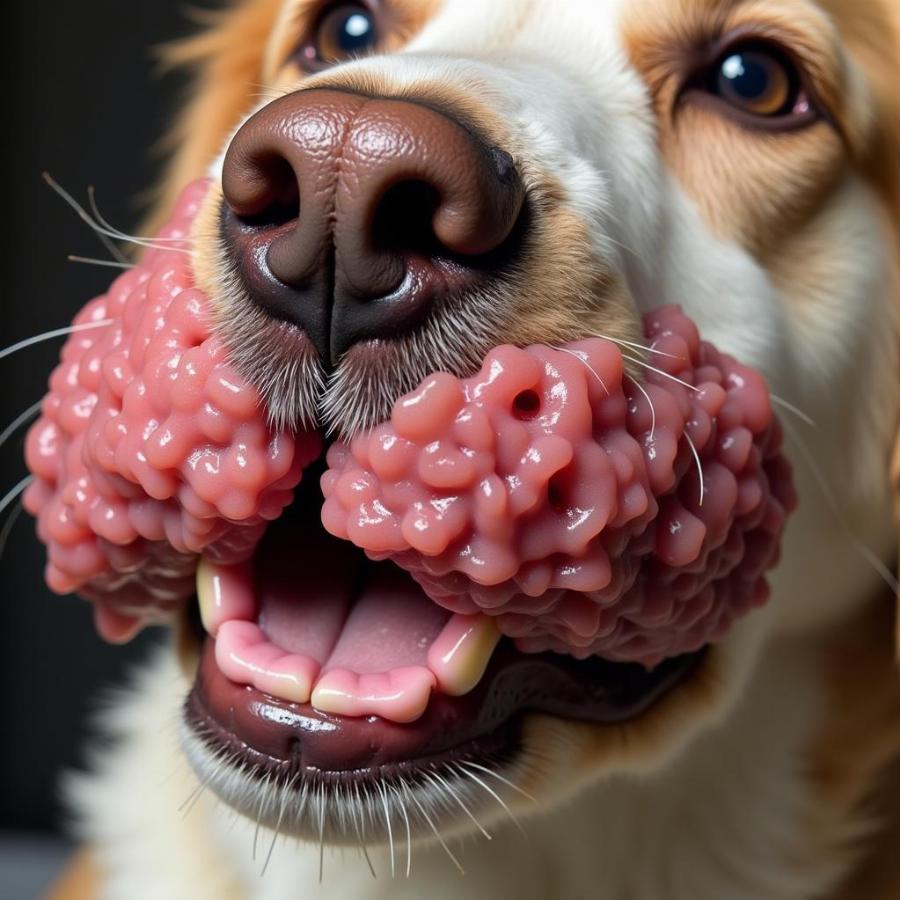Fibrosarcoma in dogs mouth is a frightening diagnosis, but understanding this disease is the first step in providing your furry friend with the best possible care. This article will guide you through the ins and outs of this aggressive oral tumor, equipping you with the knowledge to make informed decisions for your beloved companion.
Understanding Fibrosarcoma in Dogs
Fibrosarcoma is a type of malignant tumor that originates from fibrous connective tissues. When found in a dog’s mouth, it often presents as a fast-growing, firm mass on the gums, palate, or tongue. While the exact causes of fibrosarcoma are unknown, genetics, environmental factors, and chronic irritation or inflammation may play a role.
 Fibrosarcoma in a Dog's Mouth
Fibrosarcoma in a Dog's Mouth
Recognizing the Signs: Is it Fibrosarcoma?
Early detection is crucial for improving the prognosis of fibrosarcoma in dogs. Keep a watchful eye out for these potential signs:
- Unusual growths or lumps in the mouth: These may appear as swollen, red, or discolored areas.
- Bleeding from the mouth: Especially noticeable after chewing on toys or eating.
- Difficulty eating or swallowing: Your dog may struggle to pick up food or drop food from their mouth.
- Bad breath: A noticeable change in the smell of your dog’s breath.
- Facial swelling: This may occur if the tumor is large or has spread.
- Loose teeth: As the tumor grows, it can affect the surrounding teeth.
Important Note: If you notice any of these signs, schedule a visit with your veterinarian immediately. These symptoms can also be indicative of other health problems, so a proper diagnosis is essential.
Diagnosing Fibrosarcoma: What to Expect
Your veterinarian will perform a thorough physical examination, paying close attention to your dog’s mouth, teeth, and lymph nodes. To confirm a diagnosis of fibrosarcoma, they will likely recommend a biopsy. This involves taking a small tissue sample from the tumor and examining it under a microscope.
Treatment Options: Navigating the Path Forward
The treatment approach for fibrosarcoma in dogs mouth depends on several factors, including the size and location of the tumor, the stage of the cancer, and your dog’s overall health. Common treatment options include:
- Surgery: The primary treatment for fibrosarcoma is surgical removal of the tumor with wide margins. This helps ensure that all cancerous cells are removed and reduces the risk of recurrence.
- Radiation Therapy: Radiation therapy uses high-energy rays to kill cancer cells or slow their growth. It may be used alone or in conjunction with surgery, especially if complete surgical removal is not possible.
- Chemotherapy: While chemotherapy is not typically the primary treatment for fibrosarcoma, it may be used in cases where the tumor is inoperable or has spread to other parts of the body.
Living with Fibrosarcoma: Providing the Best Care
Caring for a dog with fibrosarcoma can be challenging, but there are many things you can do to keep your furry friend comfortable and improve their quality of life:
- Pain Management: Your veterinarian will work with you to develop a pain management plan to keep your dog comfortable throughout treatment and beyond.
- Nutritional Support: It is essential to provide your dog with a nutritious diet that is easy to eat and digest. Your veterinarian may recommend a soft food diet or special supplements.
- Oral Hygiene: Keeping your dog’s mouth clean is crucial, especially after surgery or during radiation therapy. Your veterinarian can advise you on the best ways to clean your dog’s teeth and gums.
- Love and Support: Above all, provide your dog with plenty of love, attention, and a comfortable environment. This will go a long way in helping them cope with their condition.
Frequently Asked Questions about Fibrosarcoma in Dogs Mouth
What is the life expectancy of a dog with fibrosarcoma in the mouth?
The prognosis for dogs with oral fibrosarcoma varies depending on the individual case. Early detection and aggressive treatment are crucial for improving the chances of survival.
Is fibrosarcoma painful for dogs?
Yes, fibrosarcoma can be painful for dogs, especially as the tumor grows and invades surrounding tissues.
Can fibrosarcoma in dogs be cured?
While complete cure is not always possible, surgery and other treatments can significantly extend the lifespan of dogs with fibrosarcoma and improve their quality of life.
Are certain breeds of dogs more prone to fibrosarcoma?
Yes, some breeds, such as Golden Retrievers, Labrador Retrievers, and German Shepherd Dogs, may be more predisposed to developing fibrosarcoma.
What should I feed my dog with fibrosarcoma?
Soft, easily digestible foods are often recommended for dogs with oral tumors.
Seeking Support and Information
Navigating a diagnosis of fibrosarcoma in your dog’s mouth can be overwhelming. Remember, you are not alone. Reach out to your veterinarian for guidance and support. They can answer your questions, address your concerns, and connect you with resources to help you through this challenging time.
Looking for More Helpful Information About Dogs?
For additional resources and expert advice on all aspects of dog care, visit Beaut Dogs at https://beautdogs.com. We are your trusted source for comprehensive and reliable information on the wonderful world of dogs.
Need personalized support? Contact our team at [email protected] for detailed and accurate answers to your questions. We are here to help!